Unveiling the Design Philosophy of BV Doshi
The Essence of BV Doshi’s Architecture
BV Doshi, an architectural visionary of India, is renowned for his profound design philosophy that seamlessly blends tradition with modernity. His approach to architecture goes beyond mere structures; it is an expression of culture, heritage, and the human experience. Let’s delve into the essence of BV Doshi’s design philosophy and uncover the principles that have shaped his iconic architectural creations.
Celebrating Cultural Context
At the heart of BV Doshi’s design philosophy is a deep reverence for cultural context. He believes that architecture should not exist in isolation but should be deeply rooted in the cultural fabric of its surroundings. Doshi draws inspiration from India’s rich architectural heritage, incorporating elements of traditional craftsmanship, materials, and motifs into his designs. This fusion of the old and the new creates buildings that not only stand as architectural marvels but also resonate with the essence of Indian culture.
Human-Centric Approach
For BV Doshi, architecture is fundamentally about the people who inhabit the spaces. His human-centric approach places the user experience at the forefront of design considerations. Whether designing a residential complex, a public institution, or a cultural center, Doshi ensures that the spaces are intuitive, welcoming, and conducive to human interaction. He believes that architecture has the power to enhance the quality of life, foster community engagement, and promote well-being.
Harmony with Nature
Another key tenet of BV Doshi’s design philosophy is a harmonious relationship with nature. He views buildings not as separate entities but as integral parts of the natural environment. Doshi often incorporates sustainable design principles, such as passive cooling techniques, natural lighting strategies, and green spaces, to minimize the environmental impact of his projects. This eco-conscious approach not only reduces the carbon footprint of the buildings but also creates healthier and more enjoyable spaces for occupants.
Fluidity of Spaces
In the world of BV Doshi’s architecture, boundaries blur, and spaces flow seamlessly from one to another. He is known for his skillful use of open layouts, interconnected spaces, and innovative circulation patterns. Doshi believes that this fluidity encourages movement, exploration, and a sense of discovery within the built environment. Whether designing a sprawling campus or a compact residence, he strives to create spaces that feel expansive, dynamic, and full of possibilities.
Embracing Sustainability
Sustainability is a guiding principle in BV Doshi’s design philosophy, long before it became a global architectural trend. He emphasizes the importance of designing buildings that are not just environmentally friendly but also socially and economically sustainable. Doshi’s projects often incorporate locally sourced materials, energy-efficient systems, and passive design strategies to reduce energy consumption and operational costs. This holistic approach to sustainability reflects his commitment to creating buildings that stand the test of time.
Emotional Connections Through Design
For BV Doshi, architecture is not just about creating functional spaces; it is about evoking emotions and telling stories. He believes that buildings should resonate with the human spirit, stirring feelings of joy, inspiration, and wonder. Doshi’s designs often feature expressive forms, intricate detailing, and thoughtful use of light and shadow to create a sense of drama and poetry. Each building becomes a narrative, inviting occupants to embark on a journey of discovery and connection.
Innovative Use of Materials and Techniques
One of the hallmarks of BV Doshi’s architecture is his innovative use of materials and construction techniques. He is known for pushing the boundaries of traditional materials, experimenting with new technologies, and collaborating with local artisans to create unique textures and finishes. Doshi’s buildings often showcase a juxtaposition of raw and refined materials, such as exposed concrete alongside delicate woodwork, creating a rich tapestry of visual and tactile experiences.
Legacy of Inspiration
As we look at BV Doshi’s body of work, we see a legacy of inspiration and innovation that continues to shape the world of architecture. His design philosophy, rooted in cultural sensitivity, human-centric principles, sustainability, and emotional resonance, serves as a guiding light for architects around the globe. BV Doshi’s buildings are not just structures; they are living embodiments of his vision—a vision that celebrates the beauty of tradition, the power of nature, and the limitless possibilities of design.
BV Doshi: A Visionary Architect
In the realm of architecture, BV Doshi stands as a visionary—a pioneer who has redefined the boundaries of design and challenged conventions. His philosophy, deeply rooted in cultural context, human experience, and environmental stewardship, has left an indelible mark on the architectural landscape of India and beyond. From the fluid spaces of the Indian Institute of Management in Bangalore to the sculptural forms of Sangath, Doshi’s buildings continue to inspire, provoke thought, and evoke a sense of wonder. As we celebrate the legacy of BV Doshi, we are reminded of the transformative power of architecture—to shape societies, elevate the human spirit, and create spaces that endure through time. Read more about bv doshi

:max_bytes(150000):strip_icc()/GettyImages-1084171152-8445a490b5894f0a9bb588dbfc2ac22d.jpg)











